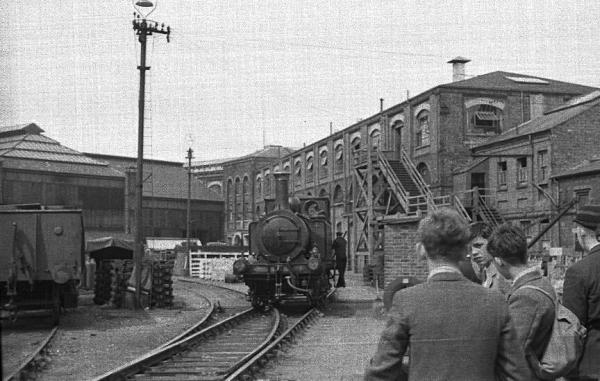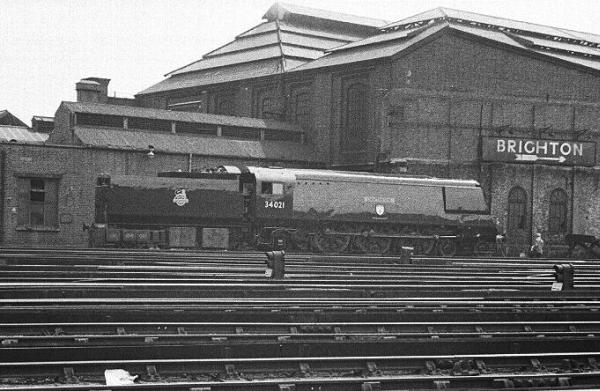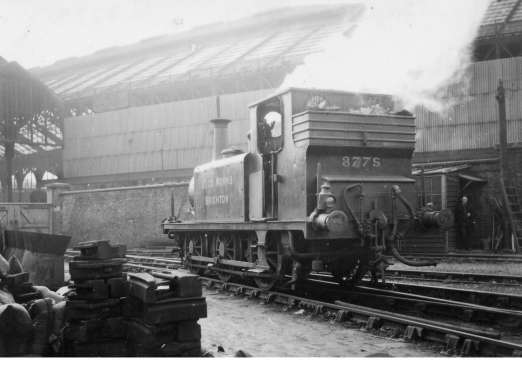I am constantly finding new photos of the Loco Works and whilst I take great pains to find the owners of the photos I use here and credit them accordingly, there are still some that I cannot yet. If I have used any that happen to belong to you and you spot them, please contact me and let me know, in order to save me any embarassment or litigation!
Thanks, Lawrence (ghost.of.loz@gmail.com)

ABOVE: Believe it or not, this photo shows the view looking across The Works looking roughly towards Hollingdean from Terminus Road. Note the Roundhill Pub at the extreme top right corner of the photo and the abundence of fields where there are now only houses: Brighton grew up primarily as a result of the railway. The view dates from 1871 and shows the original set of Works Buildings, which were consequently expanded and dramatically added to in later years as the facilities attempted to outgrow the constraints of the site.
Photos from Madgewick/Ian Allen collection, used here for illustration and personal research purposes only.

Photo from Author’s collection.

Both photos from The Madgewick Collection/Ian Allen Publishing.

********************

The site was
cleared as a result of Rationalisation in the 60’s & early 70’s and the
site was made into a huge carpark, with only the lower goods area remaining. In
the present day (2005), the 9-acre site is undergoing redevelopment. A network
of access roads have been built round the site, a development of houses and
apartments is shooting up at the southern end of the site and there are also
plans for shops, offices, hotels and restaurants.
Plans for a 400ft tall tower had been drawn up
but it appears unlikely that it will ever become a reality due to the huge
shadow it would cast across most of
Photo owned by Ian Allen / B.K.Cooper

This view (ABOVE) shows a wide shot of the whole Works building. While nothing remains of The Works in the present day, there are still hints of its existence. The majority of the brick piers which supported the extension remain, the bridge, embankment & also the retaining wall of the far end of the works foundations (immediately left of the bridge in the picture) all survive todate. The site was cleared as a result of Rationalisation in the 60’s & early 70’s and the site was made into a huge carpark, with only the lower goods area remaining. In the present day (2005), the 9-acre site is undergoing redevelopment. A network of access roads have been built round the site, a development of houses and apartments is shooting up at the southern end of the site and there are also plans for shops, offices, hotels and restaurants.
Plans for a 400ft tall tower had been drawn up but it appears unlikely that it will ever become a reality due to the huge shadow it would cast across most of Brighton! It would have contained a hotel, flats of varying sizes and a Sky Garden with spectacular views across the surrounding vista.
There are
plans for a public square & garden and the area under the extension in the photo has been
earmarked as a “Green Corridor”, a leafy pathway between the North
Laine area & the busy
Photo owned by Ian Allen Publishing.

Photo owned by D.Clayton


ABOVE: The three pictures shown here are roughly sequential and run north to south along the length of the original Works. The views above are taken from (roughly) Terminus Road and the junction with Howard Place in 1871 and shows the Montpelier Box (top left) and the dainty little platform alongside the works building. Ticket inspectors used this on down trains. This was done just short of many termini at the time and much to the annoyance of passengers, particularly as the benefits of corridors were not available.
If you CLICK on the images, larger versions of the photos can be seen.
Images owned by The Madgewick Collection / Ian Allen Publishing.

ABOVE: The southern end of the Loco Works comprised mostly Administrative and Graphic Design & Drawing Offices.
Photo owned by Charlie Verrall.






ABOVE: Photo owned by the fantastic Mr. Dewi Williams ( http://www.dewi.ca/trains/brighton/works.html)

ABOVE: Photo owned by Leslie Whitcombe.


ABOVE: This photo shows the view of the southern end of the Loco Works, as viewed from the buffer stops of Platform 10. The Design, Admin and Drawing Offices can be seen on the right hand side of the photo, where the staircase is. This photo is owned by Charlie Verrall and appears in his fantastic book 'The Search for Steam - British Rail 1951 - 1962'. The same view in the present day can be seen HERE.









